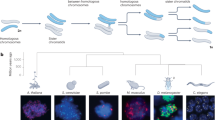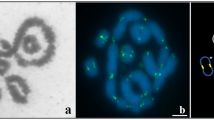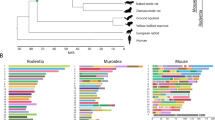Abstract
CYTOLOGICAL descriptions of meiosis have long been a staple of biology textbooks, but a biochemical account of the process with a comparable claim to universality has been unavailable. We present here evidence for a common pattern of DNA metabolism in male meiotic cells of lilies and rodents during the zygotene–pachytene stages when crossing-over is presumed to occur. The prevalence of a common pattern between species that are as phylogenetically distant as lily and mouse has led us to conclude that the organisation for meiotic crossing-over in at least higher eukaryotes is probably universal in distribution. Four components of the pattern have been identified in separate studies of lilies, mice and rats, most of which have been or are being published elsewhere1–3: the transient appearance of a protein (‘R-protein’) that facilitates DNA reannealing; the programmed introduction of single strand nicks on completion or near completion of chromosome pairing; the repair of endogenously formed nicks and gaps either immediately following or overlapping the interval of nicking; the preferential localisation of gaps and nicks in specific DNA sequences.
This is a preview of subscription content, access via your institution
Access options
Subscribe to this journal
Receive 51 print issues and online access
$199.00 per year
only $3.90 per issue
Buy this article
- Purchase on Springer Link
- Instant access to full article PDF
Prices may be subject to local taxes which are calculated during checkout
Similar content being viewed by others
References
Stern, H. & Hotta, Y. Phil. Trans. R. Soc. Lond. B. 277, 277–293 (1977).
Chandley, A. C., Hotta, Y. & Stern, H. Chromosoma 62, 243–253 (1977).
Hotta, Y., Chandley, A. C. & Stern, H. Chromsoma 62, 255–268 (1977).
Hotta, Y. & Stern, H. Devl Biol. 26, 87–99 (1971).
Hotta, Y. & Stern, H. Nature new Biol. 234, 83–86 (1971).
Hotta, Y. & Shepard, J. Molec. gen. Genet. 122, 243–260 (1973).
Mather, J. & Hotta, Y. Expl Cell Res. (in the press).
Herrick, G. & Alberts, B. J. biol. Chem. 251, 2124–2132 (1976).
Hotta, Y. & Stern, H. Chromsoma 46, 279–296 (1974).
Studier, F. W. J. molec. Biol. 11, 373–390 (1965).
Jacobson, G. K., Pińon, R., Esposito, R. E. & Esposito, M. S. Proc. Natn. Acad. Sci. U.S.A. 72, 1887–1891 (1975).
Kofman-Alfaro, S. & Chandley, A. C. Expl Cell Res. 69, 33–44 (1971).
Jones, G. H. Heredity 32, 375–387 (1974).
Smyth, D. R. & Stern, H. Nature new Biol. 245, 94–96 (1973).
Hotta, Y. & Stern, H. in The Eukaryote Chromosome (eds Peacock, W. J. & Brock. R. D.) 283–300 (Australian National University Press, Canberra. 1975).
Sobell, H. M. Proc. nat. Acad. Sci. U.S.A. 72, 279–283 (1975).
Wagner Jr, R. E. & Radman, M. Proc. natn. Acad. Sci. U.S.A. 72, 3619–3622 (1975).
Author information
Authors and Affiliations
Rights and permissions
About this article
Cite this article
HOTTA, Y., CHANDLEY, A. & STERN, H. Meiotic crossing-over in lily and mouse. Nature 269, 240–242 (1977). https://doi.org/10.1038/269240a0
Received:
Accepted:
Issue Date:
DOI: https://doi.org/10.1038/269240a0
This article is cited by
-
Two X family DNA polymerases, λ and μ, in meiotic tissues of the basidiomycete, Coprinus cinereus
Chromosoma (2007)
-
Synaptic interrelationships between the segments of the heteromorphic bivalent in double heterozygotes for paracentric inversions in chromosome 1 of the house mouse
Chromosoma (1992)
-
A model for effective pairing and recombination at meiosis based on early replicating sites (R-bands) along chromosomes
Human Genetics (1986)
-
The genetics of human reproduction
Experientia (1986)
-
DNA sequences repaired at pachytene exhibit strong homology among distantly related higher plants
Chromosoma (1982)
Comments
By submitting a comment you agree to abide by our Terms and Community Guidelines. If you find something abusive or that does not comply with our terms or guidelines please flag it as inappropriate.



